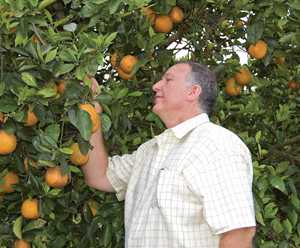Facing Down a Foe to Citrus
It seems fitting to talk in the parlance of war when discussing citrus greening. Peter McClure has been at the heart of the battle, helping coordinate the infrastructure to ensure the critical research necessary to find an answer to greening and to get it done more quickly. For seven years, McClure has served as chairman of the Florida Citrus Production Research Advisory Council (FCPRAC).
Eleven years after the psyllid was found in Florida, McClure says the infrastructure is now finally in place to aggressively take on citrus greening. But, it required the entire industry to pull together and rearrange how it has approached research efforts. McClure played a key role, making enough noise along with others to get the industry to wake up to the threat posed by citrus greening.
“The problem is this disease doesn’t have to hold meetings, doesn’t have to build consensus, doesn’t have to play politics, and finally get all the necessary approvals,” says McClure. “It is cold-blooded biology. We suffer from our complexity because we do have to do all those things.”

Preparing For Battle
Now with the industry geared up for an unprecedented charge on citrus greening, McClure is confident research will find solutions, and he hopes they come in time to keep as many current groves viable as possible.
“I’ve been on FCPRAC for more than a decade, and for many of those years, we only had $1 to $2 million a year to allocate to research,” he says. “We did a lot of good with that, but it was never designed for something like greening.”
McClure says what is needed for greening is discovery research to find solutions, and then those solutions have to be transferred from the lab through product development, commercialization, and finally to the grove.
“If we find something in the lab, we have to weaponize it,” he adds. “We have to focus on product development to get solutions in the field. It doesn’t do us any good if it stays in the lab.”
The first steps toward gearing up for this massive research effort came in 2006 when FCPRAC spent all of its available $1 million on greening and canker research. Then in 2007-2008, with all of the 1¢ per box from growers to FCPRAC, with help from funds from the Florida Department of Citrus (FDOC), and monies from the state legislature totaling $7.5 million, the effort was ramped up tremendously.
“To get the $7.5 million was really good, but it kind of overwhelmed the capabilities of the box tax council,” says McClure. “We realized it was going to take a larger effort to manage a program this size, and more importantly, we realized that the program was not big enough.
“So once we got the $7.5 million spent and off in good directions in the first quarter of 2008, we came back to industry and said we need a bigger stick. I think back then some folks were still in denial, but we brought them out to Evans Properties Inc. and showed them how bad it was in the field, and we held meetings to educate people on how serious this problem could be.”
McClure credits the Citrus Commission for really getting behind the research effort and providing leadership in bringing the industry together.
“The Citrus Commission really got ahead of this and said they would put $20 million on the table for research, but with that we’d have to really ramp up our capabilities,” he says. “The staff at FDOC has done an extraordinary job in helping to drive this process as well. They didn’t have a lot of creditability in research when this started, but I think they have gained that credit by now.”
Calling In The Troops
To select research projects and to ensure the solutions make their way to the field, the National Academy of Sciences (NAS) and a newly formed Direct Services Organization Corporation (DSOC) have been enlisted.
The NAS applied its expertise in tackling big problems and helped peer review the hundreds of proposed research projects and select the ones that will be funded with the millions of dollars now available.
“We reached out to NAS because they have such a broad range of expertise,” says McClure. “We are covering so many scientific disciplines with the proposed research, it is hard to find scientists to cover all those areas. The NAS has the ability to find scientists who can do a proper peer review and make good recommendations on research that could bear fruit.”
The first wave of 106 research projects have now been selected and funded. The research is very broad at this time because so little is known about the disease, its vector, and their interactions with the host, citrus. But, McClure says in the next year or two this will get narrowed down by results and the research will become more focused.
So what happens if one of the 106 projects provides a solution that can help mitigate or eliminate citrus greening? That is where the new corporation comes into play to move findings to a commercial stage where it can benefit growers. The DSOC is called The Florida Citrus Research and Development Foundation Inc. It is a public/private partnership utilizing the University of Florida for administrative support that is truly a separate corporation and is controlled by and will work on behalf of the Florida citrus industry. It will be managed by a board of directors made up of 10 citrus industry representatives and growers, a Florida Department of Ag representative, and two University of Florida personnel.
“You need an additional business entity to get research from the lab into actual practice in the fields,” says McClure. “This is what the corporation is designed to do and do on a much faster timeline than in the past.”
Where Does Greening Rank?
Peter McClure got a stark reminder of how serious citrus greening was when scientists from the National Academy of Sciences, core UF/IFAS, and USDA researchers, along with USDA’s elite scientists that make up their greening “swat team,” gathered last year for concurrent workshops to look at the greening problem.
“It was fascinating to watch these brilliant people that have worked with a lot of agricultural diseases and pests come together to focus on greening,” says McClure. “At the end of the meetings, I asked a question. I said ‘I am just a redneck grove foreman that stays on the end of Bluefield Road, so I don’t get out a lot. How does greening rank with other agricultural problems you’ve seen?’ The first scientist that responded said, ‘It is the worst.’ The consensus of the group was that citrus greening may be the worst disease complex that is known in a food commodity. It is a very hard problem that is going to take a lot of work to solve, and we may need to get lucky.”
The Quest For Victory
“There are 106 projects, many highly technical, any one of which may get a major hit,” say McClure. “We will get 10 or 20 significant findings out of these projects that change the game. There is no way to predict which ones yet, but it will happen.”
One area that he is particularly excited about is the near completion of sequencing the citrus greening bacteria’s genome by USDA scientists.
“I like to use the analogy of thinking of the citrus greening genome as a library with the front door locked,” says McClure. “We know inside the library there is a lot of useful information to help us fight the disease. By sequencing the genome, we unlock the door and allow the scientists in to find those secrets to help shut the disease down.
“One of the best scientists in Florida, Bill Dawson, makes the point that this is very hard science and there is not going to be an easy answer. But, on the bright side, science doesn’t have to shut down the vector, bacteria, and disease all at once. It only needs to shut down one of those to break the cycle.”
Currently, one of the main ways to fight greening is psyllid control, which McClure says is crude and expensive, but it is the only option that growers have. Research is focusing on potential biological control methods to take the psyllid out. Those efforts include a search for a predator or fungal diseases that could wipe the tiny pest out. There are also some new technologies that may render the entire psyllid population incapable of vectoring the disease.
Other research is looking at radically different production systems for citrus than currently in practice today. These include high-density plantings that are intensely managed to bring commercial production online much quicker.
“The whole idea of these new production systems is if you plant a grove and only get 10 years of productive life out them due to greening, it is still economically viable to replant and stay in business,” says McClure. “That would follow our history of agricultural production, which always increases the intensity of production systems.
“There is some really exciting research happening with some of the best scientists in the world. With the new infrastructure we have in place, along with the exceptional research program management by Dr. Tom Turpen, I believe we are finally ready to make a serious effort at finding solutions to greening.”
Rallying Together
McClure’s list of people he believes deserves credit in moving the ball on getting more research funds and attention focused on greening runs long. He says the troops are rallied and ready to fight.
“The psyllid and greening bacteria don’t know boundaries,” he says. “They don’t know or care what country, state, or county they are in. Yes, we will still have our provincial squabbles, but the troops have rallied together to fight this disease. The entire box tax council has really taken a leadership role. It has really become a group effort.”
McClure also credits his bosses at Evans Properties for allowing him to take the tremendous amount of time necessary to pore over the multitude of research proposals and attend all the meetings in his role as chairman of FCPRAC. He also credits his staff at the Bluefield Division grove for affording him time, knowing he is leaving operations in good hands.
Will We Win?
“I am certain we can find a solution for greening, maybe not in time for all groves in all areas,” says McClure. “But, the question is, will we? Will we have the guts to invest what’s necessary to find an answer? The enemy is still winning, but we are on the cusp of being able to compete.”
While McClure says he appreciates the recognition of being the 2009 Citrus Achievement Award winner, all his time and work has been done because he loves growing citrus.
“I’ve been growing citrus all my life, and I love it,” he says. “We had the choice of giving up this way of life if we didn’t fight greening. I am not going out without a fight.”
Our hearty congratulations to Peter McClure, this year’s Citrus Achievement Award winner! His example is an inspiration to us all.
At Chemtura, it’s only through working with growers, experts, and industry leaders that we can bring the products to market that meet specific grower needs.
We are pleased to be associated with hard-working, diligent professionals and it’s our hope that by honoring them and telling their stories, others will be motivated toward greater achievement.
A special thanks and congratulations to Peter, the nominees, and growers everywhere who aspire to make things better. We are grateful to be working with you to provide solutions that work for you.










